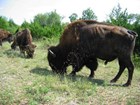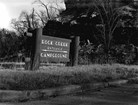The park has been part of the National Park Service since 1916, first as Platt National Park and then Chickasaw National Recreational Area. Long valued for its springs and water features, the area has been popular for camping and picnicking for over a century. Many of the landscape features are associated with NPS park development.
-
Chickasaw National Recreation Area
Article 1: Bromide Springs/Bromide Hill Cultural Landscape

The 59-acre Bromide Springs and Bromide Hill landscape is located in the western edge of the Platt National Park National Historic Landmark District. In addition to the springs, the landscape contains a large picnic area and entry landscape located on a flat terrace to the north of Rock Creek. Formerly used as a campground and gathering area, the area south of Rock Creek is a park-like landscape of grass and canopy trees, used primarily for picnicking. Read more
-
Chickasaw National Recreation Area
Article 2: Perimeter Road Cultural Landscape
The Perimeter Road is significant for its relationship to the former Platt National Park (a National Historic Landmark District). Prior to 1933, the road system consisted of an east-west route crossed by a north-south route with a few spurs located off these main roads. This was drastically changed during the 1930s, when the Civilian Conservation Corps constructed a perimeter loop road encompassing the entire park. Read more
-
Chickasaw National Recreation Area
Article 3: Buffalo Pasture/Prairie Uplands Cultural Landscape

The 392-acre Buffalo Pasture and Prairie Uplands landscape is located in the central portion of the Platt National Park National Historic Landmark District. In general, the area is primarily a natural landscape, with few visitor facilities. Today, the area is still important as a repository of early park history, as exemplified by the buffalo herd, which has been a feature in the park since 1920. Read more
-
Chickasaw National Recreation Area
Article 4: Flower Park and Black Sulphur Springs Cultural Landscape

The 35-acre Flower Park and Black Sulphur Springs landscape is located in the north central, western half of the Platt National Park National Historic Landmark District. The Black Sulphur Springs area, with its crescent shaped, lake-like beach, has maintained its historic primary use as a place for sunbathing, wading, swimming and picnicking. The focal point of this area is a pre-CCC era, Neo-classically styled pavilion. Read more
-
Chickasaw National Recreation Area
Article 5: Central Campground Cultural Landscape

The 15-acre Central Campground is the smallest of the three campground developments within the Platt National Park National Historic Landmark District. Features of the campground include Travertine Creek, which winds through the landscape, as does the Perimeter Road of the park. Panther Falls is also located nearby. The area is used for camping and associated recreational activities, including bathing in Travertine Creek. Read more
-
Chickasaw National Recreation Area
Article 6: Walnut Grove Cultural Landscape

Walnut Grove is located in the western half of the Platt National Park National Historic Landmark District. Historically, the area was the site of the Civilian Conservation Corps (CCC) Camp 808 from 1934 to 1940. The area is significant for embodying the characteristics of the type, period, and methods of construction typical of the “Rustic style” of park design developed by the National Park Service between 1916-1942. Read more
-
Chickasaw National Recreation Area
Article 7: Pavilion Springs, Hillside Spring, HQ/Maint. Area Cultural Landscape

The 48-acre Pavilion Springs, Hillside Springs, Headquarters, and Maintenance Area landscape is located in the central portion of the Platt National Park National Historic Landmark District. The buildings of the Maintenance Area and the two spring complexes are both excellent examples of the CCC-era landscape design projects undertaken in Platt National Park. In addition, the Administration building reflects earlier park usage and early settlement of the area. Read more
-
Chickasaw National Recreation Area
Article 8: Antelope and Buffalo Springs Cultural Landscape

Antelope and Buffalo Springs are part of a historic, designed landscape located on the far eastern portion of the Platt National Park National Historic Landmark District. The area is primarily used for passive recreation such as hiking, walking, and nature study. The creation of the Nature Center building and its site in the 1960s is significant for its association with Mission 66, a nationwide National Park Service effort to modernize its facilities. Read more
-
Chickasaw National Recreation Area
Article 9: Rock Creek Campground Cultural Landscape

The Rock Creek Campground was designed in the 1940s and constructed in 1951. Of the 106 campsites in the campground, about half of these (57) were constructed according to the original (1943) design layout. Rock Creek Campground is unique as an early example of pull-through campsites, a design change implemented to accommodate new, larger camping vehicles such as RVs. Read more
-
Chickasaw National Recreation Area
Article 10: Cold Springs Campground Cultural Landscape

Cold Springs Campground is located in the central eastern section of the Platt National Park National Historic Landmark District. It explicitly reflects the NPS principles of Rustic design and construction, in both overall layout and design. Particularly notable is the rustic design of the checking station, which is made of local stone and wood to blend into its surroundings in color, scale, and appearance. Read more
-
Chickasaw National Recreation Area
Article 11: Little Niagara Falls/Travertine Island Cultural Landscape

The Little Niagara Falls and Travertine Island area is located in the northeastern portion of the Platt National Park National Historic Landmark District. The landscape features exhibit classic “rustic” style design characteristics. The buildings and landscape features constructed by the CCC are made of local stone and wood, emphasize the horizontal lines of the landscape, and merge with their surroundings. Read more

